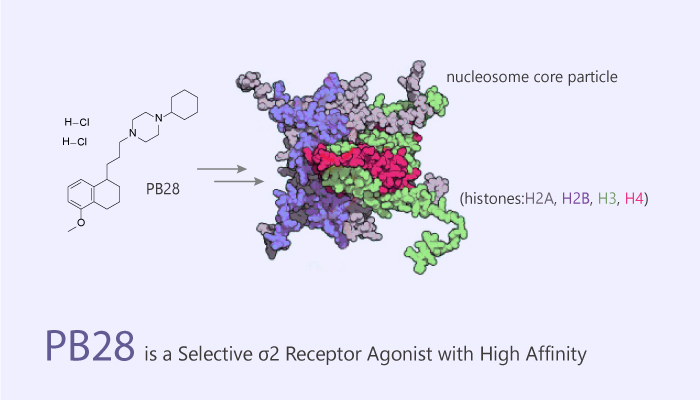Sigma Ligands has cytotoxic activity in vitro and is able to induce ceramide/caspase-independent apoptosis. In addition, these ligands down-regulate P-glycoprotein (P-gp) mRNA levels in some mouse and human models. In this article, we will introduce a mixed sigma(2) agonist/sigma(1) antagonist, PB28.
PB28 is a high affinity and selective sigma σ2 receptor agonist with a Ki of 0.68 nM. It is also a σ1 antagonist with a Ki of 0.38 nM and is less affinity for other receptors.
PB28 inhibits electrically evoked twitch in guinea pig bladder and ileum with EC50 values of 2.62 μM and 3.96 μM, respectively. It can modulate SARS-CoV-2-human protein-protein interaction. Besides, PB28 induces caspase-independent apoptosis and has antitumor activity。
Firstly, in MCF7 and MCF7 ADR cells, PB28 treatment shows accumulation in the G0-G1 phase for MCF7 and MCF7 ADR cells that are time and concentration-independent.
It has a high σ2 receptor affinity expressed as Ki (0.28 nM and 0.17 nM in MCF7 and MCF7 ADR cells, respectively). However, it has a lower σ1 receptor affinity values than for the σ2 receptor (13.0 nM and 10.0 nM, respectively).

In cell growth assay, PB28 inhibits cell viability of MCF7 and MCF7 ADR cells with IC50s of 25 nM and 15 nM, respectively after 2-day treatment.
, PB28 induces apoptosis through a caspase-independent pathway. Additionally, PB28 also reduces P-gp expression in a concentration- and time-dependent manner (approximately 60% in MCF7 and 90% in MCF7 ADR.
In C6 rat glioma and SK-N-SH human neuroblastoma cell lines, PB28 displays antiproliferative and cytotoxic effects in both.
Lastly, in C57BL/6 female mice (10 weeks old) injected with Panc02 cells, PB28 (10.7 mg/mL; intraperitoneal injection; daily; for two weeks; C57BL/6 female mice) treatment inhibits tumor growth in Panc02 tumor burden mice and confers a survival advantage for mice.
In conclusion, PB28 is a selective sigma σ2 receptor agonist and a sigma σ1 antagonist with anti-cancer activities. It inhibits the growth of breast cancer cells in vitro and inhibits tumor growth in Panc02 tumor burden mice.
Reference:
[1]. Amalia Azzariti, et al. Mol Cancer Ther. 2006 Jul;5(7):1807-16.